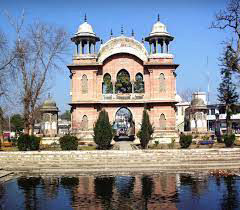
History/Introduction of The Fazlehaq College, Mardan
Peshawar region has been the nerve center of the Muslim Empire in the sub-continent. Great leaders of men in arms, administrations, statesmen, poets, architects born and bred in this area have distinguished themselves in our history. With the break-up of the empire and loss of independence, this area languished in the black water and except for a fortunate few, who exchanged conscience for gold, the community fell a prey to local feuds, decay of education and economic backwardness. In the struggle for revival and rehabilitation we lagged behind other areas and consequently our progress in economic development and education is only past story, most of it relating to the post-independence area.
In order to make up for this inherited loss and to bring this region at par with other parts of the country, intensive and extensive efforts are necessary to improve both the quality as well as the quantity of the products of our educational institutions.
Most of the Mardan division lies on the historic international route from Kabul to the sub-continent, passing through Kunar, Bajaur, Swat and Buner; the route followed by Alexander and other conquerors from North-West. During the Greek and early Mauryan period this division became the cultural capital of the successive kingdoms of Gandhara. When Fahian and Hieum Tsang, passed through this area, it was bedecked with centers of learning, art and culture of a cosmopolitan nature deriving equal inspiration from eastern and western traditions of art and culture. From 986 A.D this area came under the rule of the Sultan of Ghazni, Ghouri and the Mughal emperors. During the regime of Aurangzeb, a struggle started for reconstitution, rehabilitation and autonomous development under the inspiring leadership of Khushal Khan Kattak. His poems even today warm the hearts and ring in the ears of the people of Mardan and Baizai. After a short spell of independence, the area fell prey to internal dissension and civil strife in the Afghan kingdom and in 1818; it was over run by Sikh expansion followed by the British conquest. In 1913, a glorious attempt for freedom was made under the leadership of Syed Ahmad Shaheed but due to tribal rivalries, the movement could not make any appreciable head-way. However, it did play an important role in popularizing the political ideas of Islamic equality and social justice. During events of 1857 the 55th infantry in these areas rose up in arms against the British but was put down with a heavy had by General Nicholson and pushed into the wildness of Malakand. The movement for freedom hereafter continued from the valleys and hill tops of the tribal belt till independence in 1947. It was in 1937 that Mardan was constituted into a separate district in 1988 it was declared a division of the then N.W.F.P. Since then education, health and industry have made headway in bringing about a change in the life and outlook of the people of these areas. Their motivation and endeavor for a better life through education and economic development is very effectively reflected in the response from the Government.